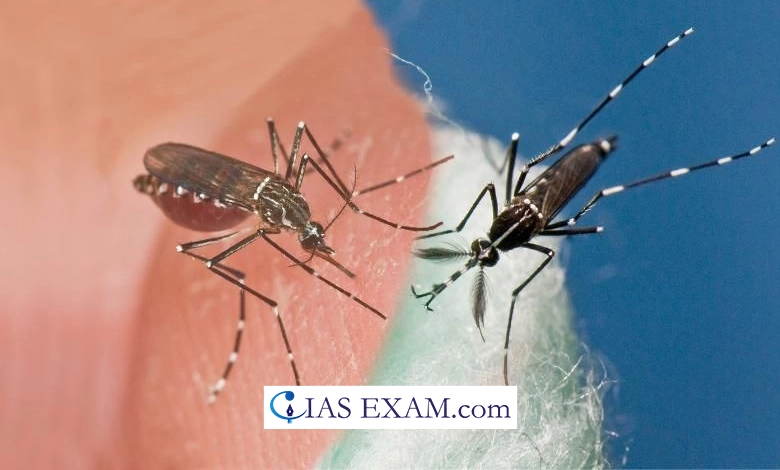New Host Defence Against Zika and Dengue
Syllabus: Science and Technology [GS Paper-3]

Context
The recent discovery in the field of virology has revealed a new type of host defence mechanism against infections like Zika and dengue.
Details
- Zika virus and dengue virus can be cited as the two top common and chief human debilitating virus infections.
- The members of the Flaviviridae family, such as Dengue and Zika viruses, mosquitoes of Aedes species primarily transmit them by biting. These viruses might cause even severe symptoms, including fever, joint pain, and even neurological disorders.
- The recent Zika and dengue virus epidemics have evidenced the requirement for being well equipped in host defences to fight insurgencies.
The Immune System’s Response to Zika and Dengue Viruses
- The immunity system is, probably, one of the most vital which was able to segment us from certain viral infections just like the Zika and dengue viruses.
- Ordinarily, the External Influence will activate different immune defences, innate immunity and adaptive immunity respectively.
- The body position induces an innate immune response firstly, which is the immediate reaction and basic defence to viral infectious agents, followed by the adaptive immune response that subsequently begins, which develops and functions through the T cells and B cells interaction.
New Type of Host Defence: RNA Interference (RNAi)
- In the case of Zika and dengue viruses RNA interference (RNAi) therefore utilises a more versatile weapon of defence which has already been effective.
- RNAi is a molecule which normally exists in cells while there is transcription process when it generates a double stranded RNA (siRNA) therefore it binds any mRNA that is complementary in order to inhibit an expression of the protein.
- This method has been known since then, which can be used to abort certain genes including those responsible for viral replication.
How RNAi Works Against Zika and Dengue Viruses
- RNAi is a method of Zika and dengue viruses turnaround, which is based on gene interference in the viral mutated genes participating in replication and translation.
- Based on RNAi technique, these pathway genes involved in replication of the viral proteins will be inhibited leading to a spectacular effect of reduced translation of viral proteins and consequently end in a total replication shutdown.
- This inborn response system which is supposed to be very efficient in containing the virus does also goes beyond its borders and can also help in reducing the showing symptoms like cough and fever in many patients.
Advantages of RNAi as a Host Defence Mechanism
RNAi offers several advantages as a host defence mechanism against Zika and dengue viruses, including:
- Specificity: As a result of RNAi being highly specific towards viral genes, there is a reduced amount of damage to non-targeted genes as well in addition to the fact that fewer side effects may be caused when implicated in the process of host cells.
- Efficiency: For RNAi the most significant function is inhibiting essential viral genes, this means that the virus is not able to multiply and it is not possible for it to read the genetic code.
- Flexibility: The RNAi approach is dedicated to the curriculum since it can at any given time be formulated to target any viral variants and mutants.
Challenges and Limitations of RNAi
While RNAi shows promise as a host defence mechanism, there are several challenges and limitations to its use, including:
- Delivery: If liver exports instead a particular cell or a tissue, then it might be difficult to implement siRNA.
- Stability: Both siRNAs may be too inert and narrow in containing all gene modifications in order for it to execute efficiently or productively.
- Immune Response: Another part that can possibly develop from using RNAi is an immune system triggering of the immune response due to which the side effects may arise
Future Prospective
- It would be helpful to do more study on RNAi to determine the most effective pathway and make it persistent for a longer duration.
- Investigate the curative and prophylactic effects of the RNAi technique in the clinical and lab experiments for the treatment of dengue and Zika viral infections.
- The technologies in the pipeline, including RNAi-based therapies, requires research which carries a promise to the public health system.
Conclusion
RNAi is a new type of host defence mechanism that shows significant potential in combating Zika and dengue viral infections. Its specificity, efficiency, and flexibility make it an attractive approach for preventing and treating these debilitating diseases. However, challenges and limitations need to be addressed through further research and development.
Source: The Hindu
UPSC Prelims Practice Question
Q. Which of the following viruses is primarily transmitted by the Aedes mosquito?
- a) Zika virus
- b) Dengue virus
- c) Both A and B
- d) None of the above
Ans – “c”





.png)



